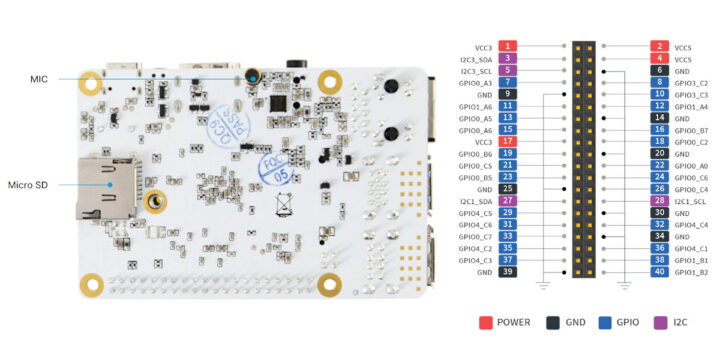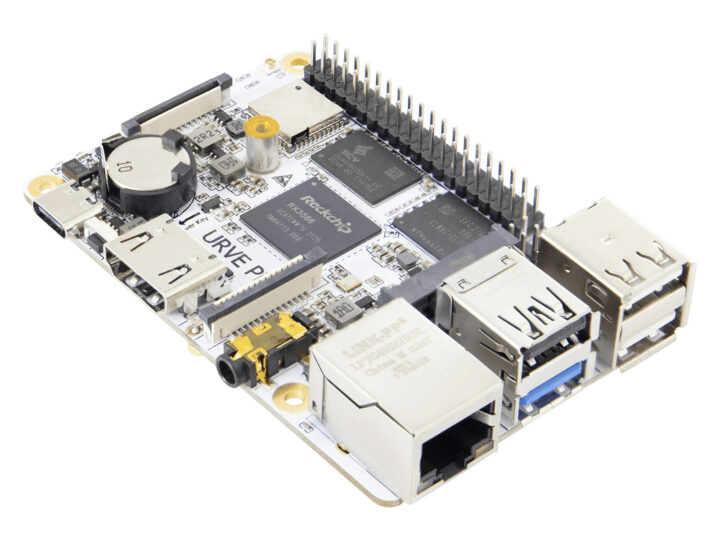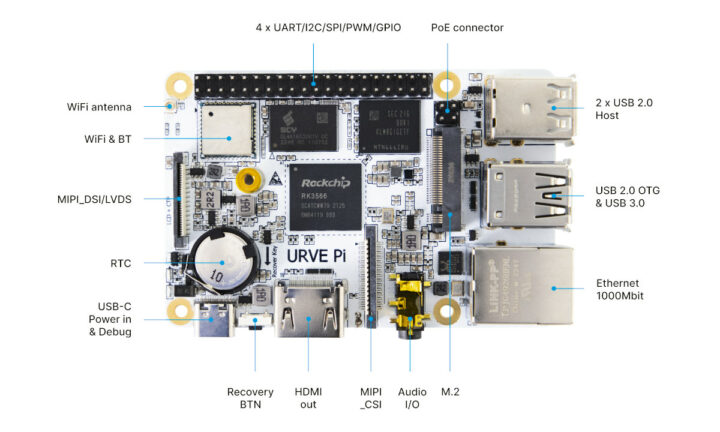URVE Board Pi is a single board computer (SBC) powered by a Rockchip RK3566 quad-core Cortex-A55 processor, 2GB RAM, 8GB eMMC flash, plus the same interfaces as the Raspberry Pi 3 Model B as well as an RTC with a coin-cell battery and an M.2 SSD socket.
More specifically, the Rockchip RK3566 board comes with a 4Kp60 capable HDMI 2.0 port, a MIPI DSI/LVDS display interface, a MIPI CSI camera connector, Gigabit Ethernet, four USB 3.0/2.0 ports, a dual-band WiFi 5.0 and Bluetooth 4.2 wireless module, and the usual 40-pin GPIO header.
- SoC – Rockchip RK3566 Quad Core Cortex-A55 processor @ 1.8 GHz with Arm Mali-G52 GPU, 0.8 TOPS NPU
- System Memory – 2GB LPDDR4 (up to 8GB)
- Storage
- 8GB eMMC flash (up to 128GB)
- M.2 PCIe socket for 2242 NVMe SSD
- MicroSD card slot
- Video Output
- HDMI 2.0 with HDCP 1.4/2.2, up to 4Kp60
- 4-lane MIPI DSI to 2560×1440 @ 60Hz or LVDS up to 1080p60
- Audio – 3.5mm Stereo audio jack, built-in microphone
- Camera I/F – MIPI CSI input
- Networking
- Gigabit Ethernet RJ45 port
- Dual 2.4GHz/5GHz WiFi 5 (802.11 a/b/g/n/ac) and Bluetooth 4.2
- USB – 1x USB 3.0 port, 2x USB 2.0 ports, 1 USB 2.0 OTG port (black), 1x USB Type-C port for power and debugging
- Expansion
- 40-pin Raspberry Pi-compatible header with 3x I2C (up to 400 kbps), 2x SPI, 4x UART, 10 PWM, 1x ADC (TBC)
- 1x M.2 PCIe socket for SSD
- Misc – Recovery button, 2x LEDs, RTC with battery
- Power Supply
- 5V/2A via USB-C port
- PoE connector
- Temperature Range – 0°C ~ 70°C (no condensation)
- Dimensions – 85 x 56 mm
- Weight – 50 grams

The company provides Android 11 and Debian 11 OS images for the board plus “URVE multimedia software” designed for digital signage applications. Note there is some confusion in the specs as SATA or PCIe show up interchangeably on the company’s website, but the user manual shows “/dev/nvme0n1” SSD so it’s definitely a PCIe/NVMe SSD, although the way Rockchip RK3566 is designed it might be possible to switch between SATA and PCIe since the interface are multiplexed. But URVE does not make any claims about this feature.
The added features against the Raspberry Pi 3 or 4 SBC are the built-in eMMC flash storage, the real-time clock (RTC) with a backup battery, the M.2 SSD socket, and a 0.8 TOPS NPU that enables running accelerated machine learning or artificial intelligence workloads without an external AI accelerator. The MIPI DSI can also take an LVDS display beyond just supporting DSI displays.

URVE multimedia software shown with a 10-inch display (not URVE Board Pi)
You’ll find a product brief, a user manual, OS images, and tools on the product page. The board is designed in Poland, so it may be interesting to European customers since customs handling and VAT issues will be taken care of, and the URVE Board Pi can be purchased on BricoGeek or TME for around 85 to 95 Euros ex. VAT. [Update: the URVE Pi SBC appears to be based on the Boardcon Compact3566 SBC we covered last year. See comments section for details]
Via LinuxGizmos

Jean-Luc started CNX Software in 2010 as a part-time endeavor, before quitting his job as a software engineering manager, and starting to write daily news, and reviews full time later in 2011.
Support CNX Software! Donate via cryptocurrencies, become a Patron on Patreon, or purchase goods on Amazon or Aliexpress. We also use affiliate links in articles to earn commissions if you make a purchase after clicking on those links.







Hi there! Great site! Did you mean Cortex-A53 or Cortex-A55 there in the 1st paragraph? Also, have you covered other boards made in Poland before?
Yes, correct, it should be Cortex-A55. I might have covered made-in-Poland boards before, but right know only TECHBASE comes to mind: https://www.cnx-software.com/news/techbase/ . But they are not making their own boards, usually just integrating existing SBCs or modules like Raspberry Pi 4 or CM4 into their products.
This looks like a fairly complete general purpose board. It’s a bit expensive for its capabilities but on the other hand it offers everything at once. I think they should provide more RAM by default in order to satisfy more use cases. This board can easily turn into a full-featured always-on browser, media-player, NAS, video recorder, data collector etc. Good job! For those who want more storage than can fit on a small NVME device, there’s now a wide choice of M.2->SATA with 2 or 4 ports in 2242 or 2260 form factor.
By the way, did you notice how similar it looks to the Compact3566 ? https://www.cnx-software.com/2022/07/25/compact3566-rockchip-rk3566-sbc-raspberry-pi-3/
In short it looks the main difference is the use of USB-C instead of micro-USB for the power.
And SATA vs nvme support at the m.2 connector
It’s the same confusion between SATA vs NVMe on both boards. The specs say PCIe, the photo SATA. I removed “SATA” after “M.2” on the URVE Pi board. Both should be NVMe, unless it’s possible to switch to SATA by software since the interfaces are multiplexed.
The M.2 position carelessly places the NAND flash directly on top of the SOC, where it will get cooked to death. Not a very well thought out design if you want to use the M.2 slot unless you’re planning to operate the SOC and SSD mostly idle, or you’re going to slide a heat pipe between them.
Yes, this is a really bad choice. The nvme usually goes on the bottom of the board..
> the NAND flash directly on top of the SOC, where it will get cooked to death.
It’s a bidirectional problem. With a cheap consumer NVMe attached to (the bottom of) my Rock 5B now the cores throttle already with medium loads and idle temperatures measured (inside the SoC as such somewhere else) increased by +15°C.
while I would generally agree, this chip doesn’t heat. I have one in a pc-station m2 and yet have to figure how to make it heat. So in this specific case I think it should be OK.
This site has reviews showing the RK3566 on OpenWRT/iperf3 benchmarks and iozone hitting 56-58C, and I would assume that’s open-air – not blocked in by an SSD. So I’m certain it would get hotter with the SSD parked on it. Then the SSD would add its own heat, getting into the 80’s or higher during iozone testing unless some active thermal management was introduced. Other review sites show it hitting 70C and throttling when playing 3D games, in plastic TV-box cases.
According to JEDEC, NAND must operate at least 1 year at 70C, but lifetime can be undefined above 70C. I used to have a PDF that graphed NAND life vs temp and the decline is logarithmic with dead in a month at 90C. That was around 2008 in the MLC days with 65nm. I’m sure today’s 128-176-layer TLC or QLC at 38nm still meets the 1 year at 70C criteria, but I’m also sure it’s sensitivity to heat above 70C is worse than the old MLC.
Still, if you don’t use it as a NAS or for 3D games, you may be ok.
Just checked, JEDEC says NAND must retain data 8 weeks at 55C ambient. So the drive is consuming an erasecount every 8 weeks at 55C, for client drives, vs every 8 *years* at 25C.
https://www.jedec.org/sites/default/files/Alvin_Cox%20%5BCompatibility%20Mode%5D_0.pdf
> Just checked, JEDEC says NAND must retain data 8 weeks at 55C ambient. So the drive is consuming an erasecount every 8 weeks at 55C, for client drives, vs every 8 *years* at 25C.
Not exactly, it’s at 55 ambient while powered off. Actually from the table, the data retention is better if the SSD is cooked in active use and cool when powered off. The 8 years you’re talking about precisely are that: 55°C active, 25°C powered off. If it runs at 25°C they claim only 58 weeks instead of 404. I have no idea what causes this dependency on Ton-Toff though.
I skipped the case where it’s 55C ambient and the NAND is powered off for weeks on end, since that’s a corner case of a corner case for consumer use.
I was confused at first too. Read the grey as powered off and the white as powered on. 55C ambient and powered off is 1 week, because the NAND won’t be getting refreshed. TLC/QLC NAND is written in multiple passes and as the electrons leak, they can be refreshed in the same way, but as it is done in bulk the individual cell levels will vary, and when that exceeds the LDPC ability to correct it, data will be lost (well some drives use overprovisioning to provide effective RAID5 so they can recover some even when the LDPC fails.) They can only refresh a few times before they must erase the block and rewrite it. So 55C and powered on retains data longer at the expense of consuming more erasecounts. Hope that makes sense now. 🙂
eMM -> eMMC
Please specify M.2 size. I guess it’s 22×60 but IDK.
I just tested their newest bsp for this board, neat kernel 5.10.
Who is “their” in “their newest bsp”? URVE / Eveo?
And what does your reply mean? With that Board Support Package you can use a plain kernel 5.10 … ?
Rockchip’s vendor/BSP kernel jumped from 4.4 to 4.19 (initial release for RK356x) to 5.10 in the meantime. And RK supports even ‘old’ SoCs like RK3399 with this 5.10 now.
Or in other words: if you want to use all RK3566/RK3568 HW features you had to use BSP 4.19 until recently and can use now BSP 5.10. Or wait a few more years until mainline is an option.
Yes, eveo webpage (I’m sorry, something deleted my link in last comment). They have BSP with everything prepared for building buildroot linux (packages), debian 11 (script for full rootfs) and Android 12 (everything). Kernel 5.10 from Rokchip is included and everything works beautifuly.
Things seem short supply everywhere, in UK still.
Best option is OKDO for Rockchip boards. RPI tarts are still AOL, mostly still
#polskagurom
Also I wonder if they will introduce RK3566-based successor to their A17 board?